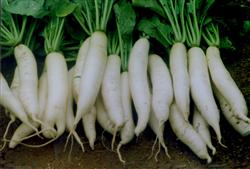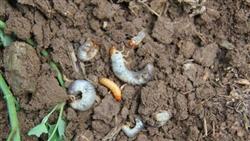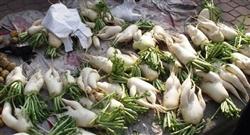Radish planting: how to grow pollution-free radish?

How to grow pollution-free radish? Please introduce in detail the planting method of planting pollution-free radish can refer to the following: selecting land to sow pollution-free radish should not be around the seriously polluted industrial plant, and the source of irrigation water should not be polluted. Radish has a wide adaptability to the soil, which generally requires deep soil layer, good water retention and drainage, and rich content of organic matter. However, radish has higher requirements for soil preparation. The field where radish is planted should be cleaned as soon as possible after the harvest of the previous crop, and should be ploughed and turned to a depth of 20-25 cm. After fertilizing, ploughing and raking, it is made into small high beds or small high ridges to prevent flooding. After fertilizer application, remove sundries such as large bricks, tiles, glass, grass roots and waste plastic film in the field to prevent radish from bifurcating or cracking when growing. Use 250-300 grams of radish seeds per mu in the field, first mix with 10-15 kg fine soil and then spread evenly (those cultivated by ridging can be planted in holes or ditches), and the cover soil is 1-1.5 cm thick after sowing. If possible, cover the sunshade net to cool and prevent rainstorm, so as to avoid the emergence of seedlings affected by the rainstorm. The general row spacing of carrots is about 30 cm, and the hole spacing is 20-25 cm. The row spacing of spring immature radish is 33 cm, and the hole spacing is 27 cm. If the weather is dry after sowing, water should be watered frequently to keep the ground moist and lower the ground temperature to facilitate seedling emergence. In case of heavy rain, it should be drained in time to prevent waterlogging. If the ridge is scoured, it should be replanted in time after the rain. Fertilizer technology radish base fertilizer is generally used in direct seeding, so base fertilizer is the main link of high yield of radish. Base fertilizer per mu can be sprinkled with mature (especially pay attention to) barnyard manure 2500-3000 kg, potassium sulfate 10 kg, superphosphate 25-30 kg, turned into the soil. In some places, base fertilizer can be applied with soil miscellaneous fertilizer and a certain amount of cake fertilizer, which can make the fleshy root grow very full, and it is not easy to be hollow during storage, which is beneficial to the production of pollution-free radish. Topdressing for the first time when the seedlings grew to a true leaf, topdressing 1000 kg of rotten rarefied human feces and urine. After fixing the seedlings, we applied 1500 kilograms of mature human feces and urine and 5 kilograms of superphosphate and 5 kilograms of potassium sulfate for the third time when the fleshy root was "broken belly" (the beginning of expansion and accelerated growth of fleshy root). Carrots are generally applied only these three times, and spring immature radish can be fertilized 1-2 times during the peak period of fleshy root growth. if the aboveground leaves are particularly thick and green, they can no longer be fertilized, and it is necessary to spray 15% paclobutrazol 20 grams of water to inhibit aboveground growth and promote the expansion of underground fleshy roots. If too much nitrogen fertilizer is applied, when the air and soil are dry, and the root is damaged, the absorption of calcium by the plant will be hindered, the leaf edge will rot, the root surface will produce deep hair holes, many lateral roots and so on. Therefore, the amount of nitrogen fertilizer should be controlled in the later stage of radish growth, and attention should be paid to the supply of boron in soil to prevent radish from producing hollow and black heart. In the field management, the seedlings were fixed, the radish seedlings and the seedlings at the stage of 2-3 true leaves were each once. Set seedlings with 4-5 true leaves and leave one plant in each hole. Fertilizer and water management radish is afraid of both drought and dampness. Rain Water should drain and reduce stains in time. Radish has large leaf area, strong transpiration and poor drought resistance, so it is necessary to supply enough water at the right time. Fully water before sowing to ensure that seedlings emerge quickly and neatly; seedling and rosette stage should be watered less to promote taproot to go deep into the soil layer, prevent leaves from growing too long, and master the principle of "the ground is not dry and irrigated, the surface is white before watering"; the root growth period should be fully uniform water supply, promote fleshy root expansion, prevent hollowness, improve quality, and enhance storage resistance. Watering in the evening is better for autumn cultivation, which is beneficial to reduce the soil temperature and promote the transport and storage of nutrients to the roots. The fertilization principle of radish is "based on base fertilizer and supplemented by topdressing". Varieties with sufficient base fertilizer and short growth period can be less topdressing, and varieties with long growth period should be topdressing by stages, with emphasis on fertilizer application in the early growth stage and the peak growth period of fleshy root. Pest control of radish diseases and pests are mainly aphids, ape leaf insects, cabbage insects, yellow striped beetle, beet armyworm, as well as virus diseases, black rot, etc., in order to make radish pollution-free, we should pay attention to the following points. First, reasonable rotation, reasonable close planting, cleaning the countryside, improving the field microclimate environment and reducing the occurrence and harm of diseases; second, the use of sunshade net and anti-insect net covering technology can reduce the occurrence of pests such as cabbage pest and beet armyworm; third, the selection of biological pesticides, high-efficiency and low-toxic pesticides, adhere to the appropriate period of drug use, appropriate amount of medicine. Fourth, the interval between the use of drugs should be strict, and should be stopped 2 weeks before harvest. When the fleshy root of radish is fully expanded and the leaf color turns to yellow and green, the radish should be harvested and listed in time. As far as possible timely and early harvest, on the one hand, it can improve economic benefits, on the other hand, it can avoid bran heart caused by factors such as expired growth or drought. If the radish planted in the planting environment and the commodity itself meets the requirements of the "three products" (pollution-free agricultural products, green food, and organic food), and the growers are willing to improve the grade of their own radish, you can apply for the "three products" from the relevant government departments. Click for more radish planting techniques click to get more vegetable planting techniques
- Prev

Sweet potato cultivation: how to control underground pests without pollution?
How does sweet potato control underground pests without pollution? Please introduce the method of planting sweet potato, which is easy to be damaged by underground pests, form insect path, make sweet potato rot, reduce its quality, and cannot be eaten seriously, resulting in reduced production and loss of harvest. Can refer to the following pollution-free methods to control sweet potato underground pests, neither any toxic residue, nor.
- Next

Radish planting: why does radish have a deformed black heart?
Why does radish have a deformed black heart? Please introduce the causes of radish malformed root, split root, black skin, black heart or bran heart, bitter taste, spicy taste, caused by the following factors: 1. Malformed root. Rain Water is large, irrigated too much, the soil is hardened; unrotten organic fertilizer or uneven fertilization; the soil tillage layer is too shallow, or hard under the roots.
Related
- Where is it suitable to grow horseradish in China? it is expected to see the middle altitude horseradish in Alishan.
- How to prevent tomato virus disease reasonably? (Control methods included)
- Many people like to plant towel gourd on the balcony. What are the main points of this method and management?
- What crops can chili peppers be mixed with?
- Fertilization techniques and matters needing attention in Tomato
- What are the grafting techniques for peach seedlings in spring?
- Harm and control methods of root swelling disease of Chinese cabbage
- What are the pests of sweet potatoes? How to prevent and cure it?
- Symptoms, causes and Control methods of navel Rot in Tomato
- The cause of "Cucumber rotten bibcock" in Farmers' planting Cucumber and its Control Plan

